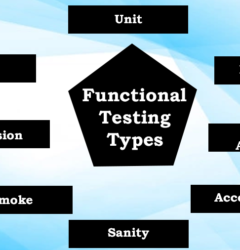11 May

What is functional testing?
Functional testing is a critical component of software testing that helps ensure that an application or system performs a specific function as intended. It’s a process of verifying and validating the software against its functional requirements, specifications, and business needs. Functional Testing is an essential part of the software development process, and it aims to identify any defects, errors, or bugs that may prevent the software from functioning correctly.
Functional testing is different from other types of software testing, such as non-functional testing, as its primary focus is on the software’s functionality. Functional testing is critical in delivering high-quality software that meets the needs of users, and it’s essential to identify and fix any issues or bugs as early as possible.
Why is functional testing important?
Functional testing is essential because it helps ensure that the software meets its intended purpose and functions correctly. Without functional testing, software developers may release applications that have bugs or defects, which can lead to customer dissatisfaction, loss of revenue, and a damaged reputation. Functional testing is also critical in ensuring that the software is user-friendly and meets the needs of its target audience.
Functional testing helps identify any issues or bugs early in the software development process, making it easier and less expensive to fix. It also helps ensure that the software is reliable, accurate, and performs as expected. In addition, functional testing helps ensure that the software complies with industry standards, regulations, and guidelines.
Types of Functional Testing.
Functional testing can be divided into several types, including:
Unit Testing
Unit testing is the testing of individual components or modules of the software to ensure that each unit functions correctly. It’s often the first type of functional testing performed in the software development process and is typically carried out by developers.
Integration Testing
Integration testing is the testing of the interactions between different components or modules of the software to ensure that they work together as intended. Integration testing is usually carried out after unit testing and helps identify any issues or bugs that may arise when different components are integrated.
System Testing
System testing is the testing of the entire software system to ensure that it meets its functional requirements. System testing is typically carried out by testers and helps identify any issues or bugs that may arise when the software is used in a real-world environment.
Acceptance Testing
Acceptance testing is the testing of the software against its requirements and specifications to ensure that it meets the needs of the users and stakeholders. Acceptance testing is typically carried out by end-users or stakeholders and helps ensure that the software is fit for purpose.
Regression Testing
Regression testing involves retesting the software after modifications or changes have been made to ensure that the existing functionalities have not been impacted. It helps in identifying any new defects that may have been introduced due to changes in the software.
Smoke Testing
Smoke Testing is performed to quickly evaluate the basic functionality of a software build or release to determine if it is stable enough for further testing. It typically involves testing a small set of critical functionalities.
Sanity Testing
Sanity testing is usually performed manually and may include checking features such as installation, login, basic navigation, data input/output, and critical functionality that has been recently modified or fixed. It may also involve checking for compatibility with different hardware or software configurations, basic performance or load testing, and verifying that any known defects or issues from previous builds or releases have been addressed.
The functional testing processes
The functional testing process typically involves the following steps:
Test planning
Test planning involves defining the scope of the testing, identifying the functional requirements to be tested, and determining the testing approach and methodology to be used.
Test design
Test design involves developing test cases and test scenarios based on the functional requirements and specifications.
Test execution
Test execution involves running the tests and recording the results.
Test reporting
Test reporting involves documenting the test results and communicating them to stakeholders.
Conclusion
Functional testing is a critical aspect of software testing that ensures that an application or system meets its intended purpose. It’s essential to identify and fix any issues or bugs as early as possible, as this can help reduce the cost of development and maintenance and improve software quality and user satisfaction. By following best practices and using the right tools, functional testing can be carried out efficiently and effectively, ensuring that software meets the needs of its users and stakeholders.
Gaurang Solanki works as a Manual Tester at QACraft. He is a Computer Science Engineer with a degree and has 6+ months of experience in Software Testing. In his free time, he loves to do Reading & watching tutorials for upgrading technical skills.
Related Post
Recent Posts
Categories
- Agile Testing
- Android App Testing
- Automation Testing
- Banking Domain Testing
- Beta Testing
- cloud testing
- Corporate Life
- cross browser testing
- Cypress Testing
- desktop testing
- Domain Testing
- E-commerce Website Testing
- E-learning App Testing
- Functional Testing
- Game Testing
- Healthcare Domain Testing
- Infographics
- Ios App Testing
- Jenkins
- JIRA
- Katalon
- Manual Testing
- Mobile App Testing
- monkey testing
- Performance Testing
- Salesforce Testing
- security testing
- Selenium
- Software Testing
- static testing
- Test Environments
- vdfv
- Web Application Testing
© Copyright 2024 QACraft Pvt. Ltd. All rights reserved.
Contact : +91 9157786796


Gaurang